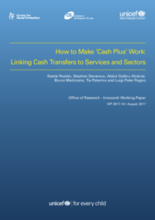ABSTRACT
The broad-ranging benefits of cash transfers are now widely recognized. However, the evidence base highlights that they often fall short in achieving longer-term and second-order impacts related to nutrition, learning outcomes and morbidity. In recognition of these limitations, several ‘cash plus’ initiatives have been introduced, whereby cash transfers are combined with one or more types of complementary support. This paper aims to identify key factors for successful implementation of these increasingly popular ‘cash plus’ programmes, based on (i) a review of the emerging evidence base of ‘cash plus’ interventions and (ii) an examination of three case studies, namely, Chile Solidario in Chile, IN-SCT in Ethiopia and LEAP in Ghana. The analysis was guided by a conceptual framework proposing a menu of ‘cash plus’ components. The assessment of three case studies indicated that effective implementation of ‘cash plus’ components has indeed contributed to greater impacts of the respective programmes. Such initiatives have thereby addressed some of the non-financial and structural barriers that poor people face and have reinforced the positive effects of cash transfer programmes. In design of such programmes, further attention should be paid to the constraints faced by the most vulnerable and how such constraints can be overcome. We conclude with recommendations regarding the provision of complementary support and cross-sectoral linkages based on lessons learned from the case studies. More research is still needed on the impact of the many variations of ‘cash plus’ programming, including evidence on the comparative roles of individual ‘plus’ components, as well as the knowledge, attitudes and behaviour pathways which influence these impacts.

